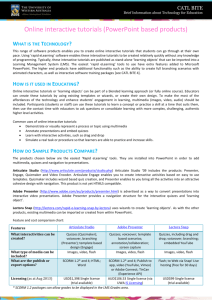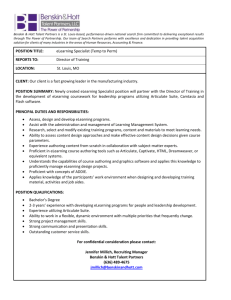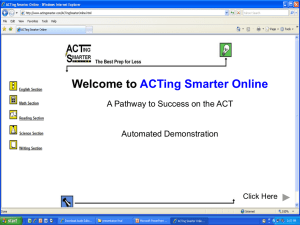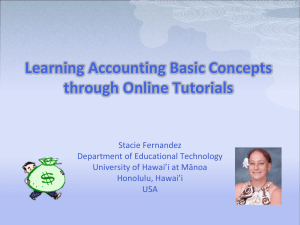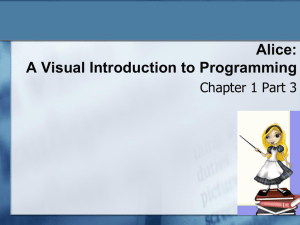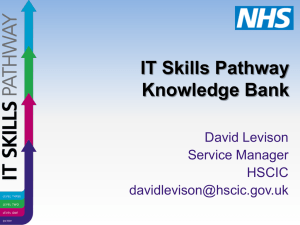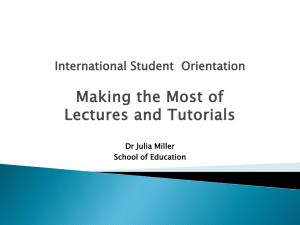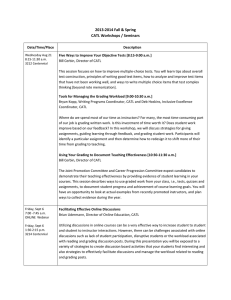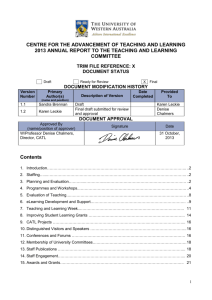CATL BITEs - Education at UWA
advertisement
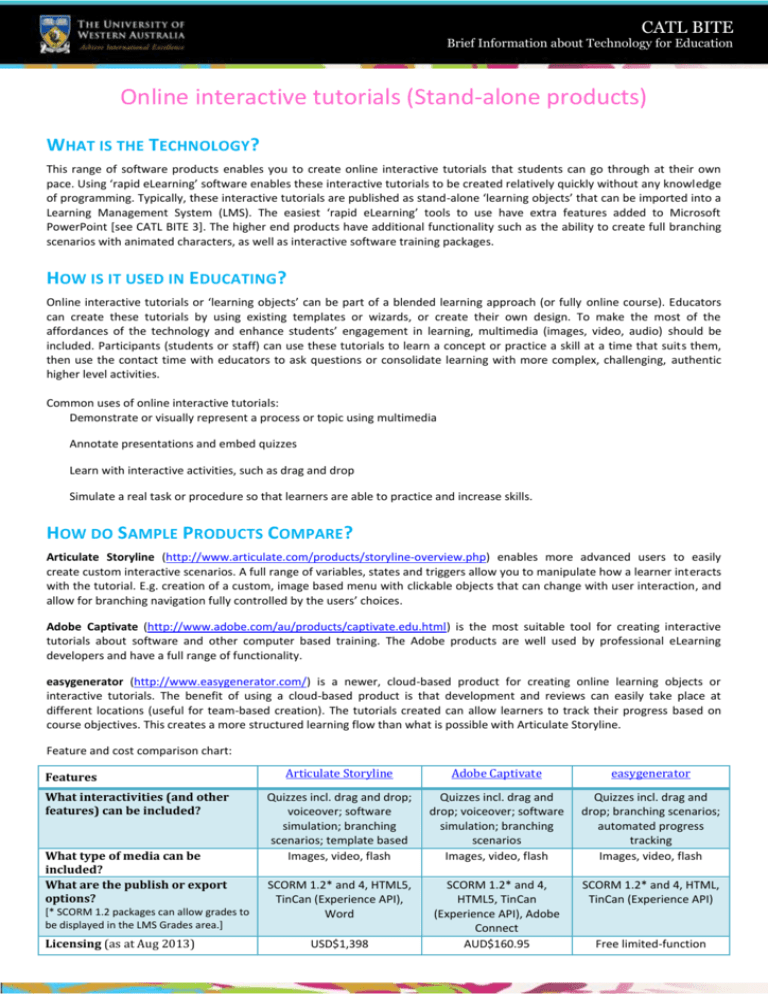
CATL BITE Brief Information about Technology for Education Online interactive tutorials (Stand-alone products) WHAT IS THE TECHNOLOGY? This range of software products enables you to create online interactive tutorials that students can go through at their own pace. Using ‘rapid eLearning’ software enables these interactive tutorials to be created relatively quickly without any knowledge of programming. Typically, these interactive tutorials are published as stand-alone ‘learning objects’ that can be imported into a Learning Management System (LMS). The easiest ‘rapid eLearning’ tools to use have extra features added to Microsoft PowerPoint [see CATL BITE 3]. The higher end products have additional functionality such as the ability to create full branching scenarios with animated characters, as well as interactive software training packages. HOW IS IT USED IN EDUCATING? Online interactive tutorials or ‘learning objects’ can be part of a blended learning approach (or fully online course). Educators can create these tutorials by using existing templates or wizards, or create their own design. To make the most of the affordances of the technology and enhance students’ engagement in learning, multimedia (images, video, audio) should be included. Participants (students or staff) can use these tutorials to learn a concept or practice a skill at a time that suits them, then use the contact time with educators to ask questions or consolidate learning with more complex, challenging, authentic higher level activities. Common uses of online interactive tutorials: Demonstrate or visually represent a process or topic using multimedia Annotate presentations and embed quizzes Learn with interactive activities, such as drag and drop Simulate a real task or procedure so that learners are able to practice and increase skills. HOW DO SAMPLE PRODUCTS COMPARE? Articulate Storyline (http://www.articulate.com/products/storyline-overview.php) enables more advanced users to easily create custom interactive scenarios. A full range of variables, states and triggers allow you to manipulate how a learner interacts with the tutorial. E.g. creation of a custom, image based menu with clickable objects that can change with user interaction, and allow for branching navigation fully controlled by the users’ choices. Adobe Captivate (http://www.adobe.com/au/products/captivate.edu.html) is the most suitable tool for creating interactive tutorials about software and other computer based training. The Adobe products are well used by professional eLearning developers and have a full range of functionality. easygenerator (http://www.easygenerator.com/) is a newer, cloud-based product for creating online learning objects or interactive tutorials. The benefit of using a cloud-based product is that development and reviews can easily take place at different locations (useful for team-based creation). The tutorials created can allow learners to track their progress based on course objectives. This creates a more structured learning flow than what is possible with Articulate Storyline. Feature and cost comparison chart: Features What interactivities (and other features) can be included? What type of media can be included? What are the publish or export options? [* SCORM 1.2 packages can allow grades to be displayed in the LMS Grades area.] Licensing (as at Aug 2013) Articulate Storyline Adobe Captivate easygenerator Quizzes incl. drag and drop; voiceover; software simulation; branching scenarios; template based Images, video, flash Quizzes incl. drag and drop; voiceover; software simulation; branching scenarios Images, video, flash Quizzes incl. drag and drop; branching scenarios; automated progress tracking Images, video, flash SCORM 1.2* and 4, HTML5, TinCan (Experience API), Word SCORM 1.2* and 4, HTML5, TinCan (Experience API), Adobe Connect AUD$160.95 SCORM 1.2* and 4, HTML, TinCan (Experience API) USD$1,398 Free limited-function CATL BITE Brief Information about Technology for Education Features Articulate Storyline Adobe Captivate easygenerator Single license (other pricing models available; 30 day trial available) Single license (via UWA IS Licensing) version available; full function costs USD$1,250 for 12mth subscription DID YOU KNOW? The Lesson activity tool in LMS allows you create branching scenarios or mini tutorials. Use the HTML editor to create pages that set the scene – you can include images and/or video – then use quiz-type questions and the subsequent student response to branch off to different pages. There are some tips and ideas on the Moodle website, especially under ‘Using Lesson’: http://docs.moodle.org/24/en/Lesson_module For LMS (Learning Management System) help email help-elearning@uwa.edu.au or call 6488 8190. WHAT DOES CATL RECOMMEND? First you need to review your situation and requirements. The products listed above are more comprehensive and can require some knowledge or skills. Captivate is typically used more heavily for software simulation (teaching others to use software) and may be more suitable if you are already using other Adobe products. Articulate products are recommended, though, because of their ease of use, adaptability and community support. Articulate Storyline is a good all-round, versatile product which CATL believes is best for creating independent, interactive learning experiences. One particular benefit is the ability to create scenarios based on free text response questions, with no grading required (an LMS Lesson requires grading of essay type questions). WHERE CAN I FIND MORE INFORMATION ? The most important thing when using these tools is to consider the learning design: Herrington, J. (2006). Authentic e-learning in higher education: Design principles for authentic learning environments and tasks. World Conference on E-Learning in Corporate, Government, Healthcare, and Higher Education. Siragusa, L., Dixon, K.C., & Dixon, R. (2007). Designing quality e-learning environments in higher education. Proceedings from ascilite, In ICT: Providing choices for learners and learning. Laurillard, D. (2010). Effective Use of Technology in Teaching and Learning in HE. In: Penelope Peterson, Eva Baker and Barry McGaw, Editor(s)-in-Chief, (2010). International Encyclopaedia of Education (Third Edition), Pages 419-426, doi: 10.1016/B978-008-044894-7.00867-8. Some additional useful resources: A commercial eLearning company, Kineo, includes thorough reviews of Rapid eLearning Authoring Tools on their website: http://www.kineo.com/authoring-tools/rapid-e-learning-authoring-tools.html. Use the menu on the left to read reviews of individual tools. There are also some tips for tool selection. Even if you don’t use the products, Articulate’s ‘The Rapid E-Learning Blog’ is a fantastic source of tips, tricks and ‘freebies’ for creating eLearning: http://www.articulate.com/rapid-elearning/ An overview of the design process is available in CDC’s E-Learning Essentials: http://www.cdc.gov/learning/local/pdf/ElrngEsstls.pdf WHO CAN I TALK TO ABOUT THIS EDUCATIONAL TECHNOLOGY? CATL eLearning staff can help you explore ways to use these kinds of technology in your teaching. Contact helpelearning@uwa.edu.au for an Educational Developer or eLearning Academic to discuss ways to use this type of technology in your teaching practice CATL BITES CATL BITEs (Brief Information about Technologies for Educating) are developed by CATL educational developers to inform UWA staff about current and emerging technologies for technology-integrated learning. Technologies are selected as a result of queries to CATL, environmental scans, and conversations in the UWA community. For more BITEs, see: www.catl.uwa.edu.au/e-learning/evaluatingtechnologies To request CATL review a type of educational technology, send an email to: help-elearning@uwa.edu.au
